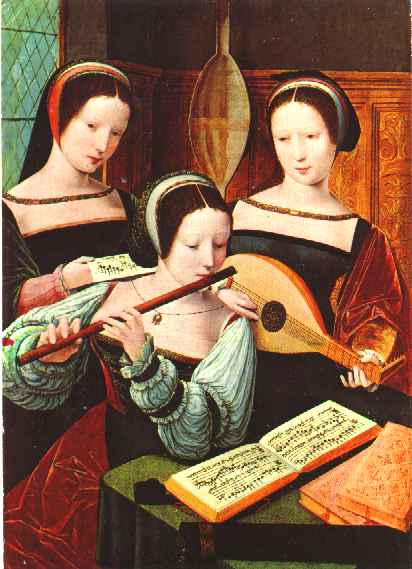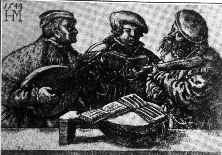|
The Concert, 1530
by
The Master of the Half Lengths
This pair of paintings both show ostensibly the same scene: a trio of girls, one singing from her own music sheet, a lute-player and a flute-player both apparently playing from a single part book.
The lutes are very typical of renaissance six course instruments, with what look to be 9 or 11 rib backs of maybe yew or sycamore with a light coloured varnish, pegboxes nearly at right angles to the neck, boxwood coloured fingerboards ending in a straight line joint at the junction with the soundboard instead of the later design with “points”. The rose on the Hermitage instrument is small and neat but the size and apearance of the rose on the Vienna lute is very similar to another Master of the Half Lengths lute in a picture in Hannover Provincial Museum, and in both these lutes the roses appear to be painted or maybe gilded much darker than the rest of the soundboard. This might make one think that the roses were made separately and inset into the soundboard except that this is almost unknown in genuine surviving lutes; moreover some surviving lutes do have roses showing traces of some kind of painted or gilded decoration, this shows up most clearly in an X-ray of one of the lutes in Brussels, so it is very likely that these pictures show painted roses.
Both lutes are being played standing up with the pegbox in the “head-down” position which has been the subject of some discussion in the lute net in recent months. And in both cases the player’s left hand thumb is well over the top of the neck; though whether it is being used to stop the lowest course is a moot point.
What I would like to concentrate on this month though, is the lute case. This is the strange looking object apparently hanging on the wall between the lute-player and the singer. These cases seem to be the standard pattern of the period and are somewhat different from present-day cases in that the lids open from a hinge across the top at the widest point of the lute, instead of from the side of the case. This is because the cases themselves were made just like lutes: out of thin staves of wood bent and glued together before being covered with thin leather. This meant that the case itself would be too floppy to hold its shape with a side-hinged lid and, being more or less rounded at the back, would be too unstable to stand up with an open side-hinged lid. Both these difficulties were solved by the end-on opening lids which allowed for a very strong but light structure of minimum bulk. The bar and hinge across the widest point made a rigid point of strength just where the lute is most vulnerable and the lid (before the invention of plywood) most weak. Modern plywoods have allowed made-to-measure casemakers such as Kingham to build side opening lids with security; but in order to solve the stability problem they have had to make cases with wider bases, thus increasing their bulk. The cases shown in paintings were commonly lined with a striped material as shown here. And usually the cases are littered about on the floor or used as foot-rests or music stands for the players, just as in modern times. However in these paintings the cases are hanging neatly out of the way on the wall allowing the flat lids to hang down and showing the hollow interior of the upper part of the case.
However there is one detail which worries me: the lid of the case in the Vienna painting does not seem to be flat! In fact the painter appears to think of it as hollow in just the same way as the revealed back of the case. This is quite unlike the lid of the Hermitage painting and does make me wonder if the Vienna painting is in fact a copy of the Hermitage painting by an artist who did not quite understand what this object was! I would be interested, therefore, if any of you could tell me if the music in the Vienna painting looks as plausible as that in the Hermitage painting. In both cases it is Jouissance vous donneray
by Claudin de Sermisy (c.1490-1562) a translation of the text is given in full on the webpage: http://music.acu.edu/www/iawm/pages/renconsort.html
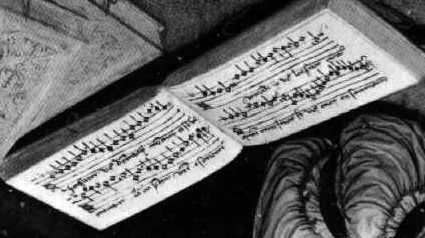
The music for the flautist (turned the right way up)
Vienna copy
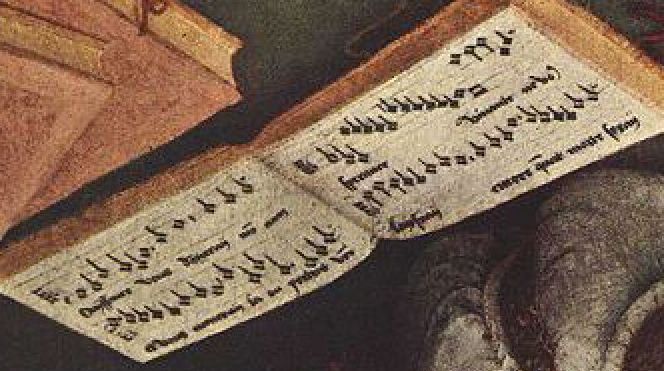
The music for the flautist (turned the right way up)
Hermitage copy.
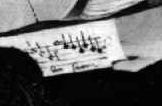
The music for the singer (turned the right way up)
Vienna copy

The music for the singer (turned the right way up)
Hermitage copy
One further little detail is the multiple flute case on the table in the foreground. One must suppose that this held flutes of different pitches or different temperaments as with the Holbein Ambassadors painting.
As an illustration of this theme of cases I append a few more pictures of the typical lute case of the renaissance.
|
